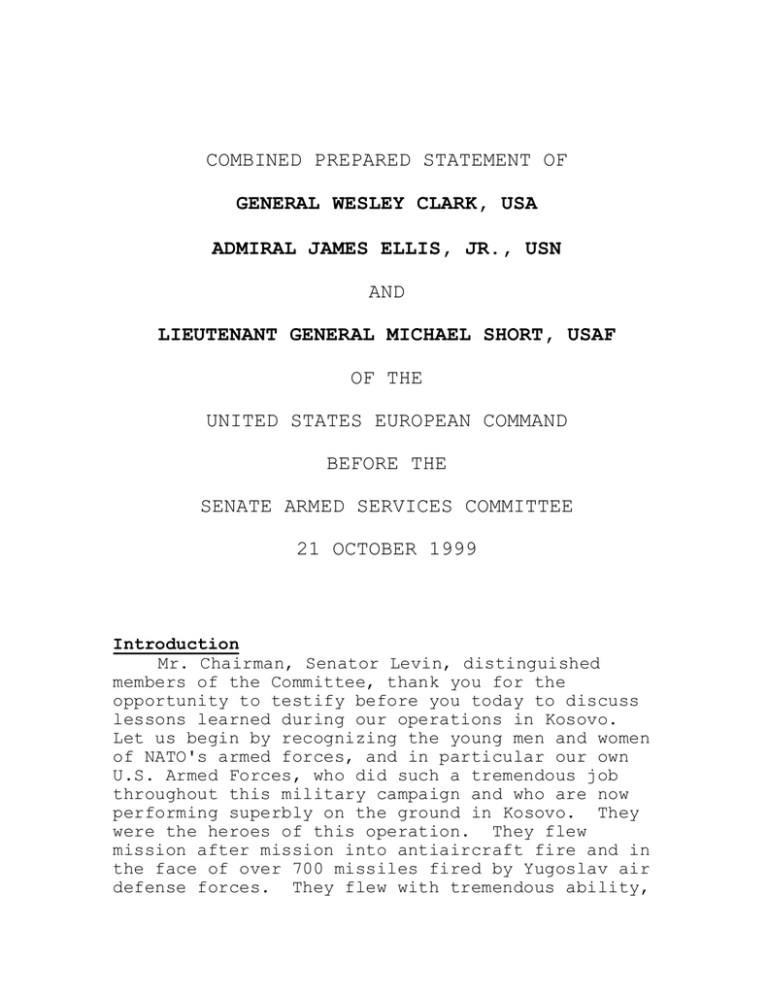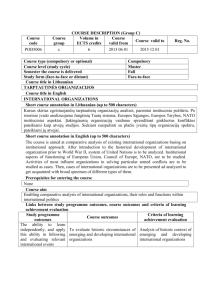COMBINED PREPARED STATEMENT OF AND OF THE UNITED STATES EUROPEAN COMMAND
advertisement

COMBINED PREPARED STATEMENT OF GENERAL WESLEY CLARK, USA ADMIRAL JAMES ELLIS, JR., USN AND LIEUTENANT GENERAL MICHAEL SHORT, USAF OF THE UNITED STATES EUROPEAN COMMAND BEFORE THE SENATE ARMED SERVICES COMMITTEE 21 OCTOBER 1999 Introduction Mr. Chairman, Senator Levin, distinguished members of the Committee, thank you for the opportunity to testify before you today to discuss lessons learned during our operations in Kosovo. Let us begin by recognizing the young men and women of NATO's armed forces, and in particular our own U.S. Armed Forces, who did such a tremendous job throughout this military campaign and who are now performing superbly on the ground in Kosovo. They were the heroes of this operation. They flew mission after mission into antiaircraft fire and in the face of over 700 missiles fired by Yugoslav air defense forces. They flew with tremendous ability, confidence, and courage. They could see with their own eyes the destruction and devastation of the ongoing ethnic cleansing. They were determined to stop it and they did. Operation ALLIED FORCE As always, we are grateful for the tremendous support the members of this committee provided throughout Operation ALLIED FORCE. Many of you visited our troops during the past few months and have seen our operations first-hand. We could not have succeeded in this difficult endeavor without your strong support. NATO Goals. This was a victory for the United States and for NATO. NATO emerges from this conflict a stronger alliance, and the premier transatlantic security organization entering the 21st century. The enduring achievement of the Alliance was maintaining unity and resolve throughout the 78-day air campaign. Our diplomatic conditions for the termination of the air campaign were clearly articulated by Alliance leaders: $ A verifiable stop to all military action and the immediate ending of violence and repression; $ Withdrawal from Kosovo of Yugoslav military, police, and paramilitary forces; $ Stationing in Kosovo of an international military presence; $ Unconditional and safe return of all refugees and internally displaced persons and unhindered access to them by humanitarian aid organizations; and $ Establishment of a political framework for Kosovo, on the basis of the Rambouillet Accords, in conformity with international law and the Charter of the United Nations. Our mission was to degrade and disrupt the Armed forces of Yugoslavia conducting the campaign of ethnic cleansing in Kosovo. On the part of the commanders, it required that we adapt our military doctrine and strategy to strike a balance between maintaining allied cohesion, striking key elements of the Yugoslav armed forces and their supporting infrastructure, minimizing losses of allied aircraft, and minimizing collateral damage. The Air Campaign. Planning for Operation ALLIED FORCE included four operational phases and a redeployment phase. NATO launched this campaign on 24 March against Slobodan Milosevic's regime of repression. We started with 366 aircraft and executed 40 missions the first night. At the conclusion, NATO had assembled a force of more than 900 aircraft, two-thirds of which were American. During the following 78-day air campaign, NATO forces flew over 38,000 sorties including over 14,000 strike sorties with only two aircraft (F-117 and F-16) and no crewmembers lost to hostile action. We delivered over 23,000 weapons of various types during the conflict. The accuracy of our strikes and minimal collateral damage set new standards for a military operation of this size, scope, and duration. Fewer than 20 incidents of collateral damage occurred. Despite the best efforts of Serb propaganda, most understood very well that NATO did everything possible, everything feasible, to focus on the enemy and keep harm away from innocent civilians. This was in stark contrast to Serbian Army and paramilitary forces, which were deliberately and systematically conducting a well-planned and brutal campaign of ethnic cleansing against civilians as a matter of state policy. The success of Operation ALLIED FORCE is a testament to the political unity and courage o-f NATO members in the face of adversity. NATO's solidarity remained despite domestic political challenges in Alliance nations. Fourteen of nineteen Alliance nations contributed forces, including 305 aircraft. These aircraft flew over 15,000 sorties. In addition, NATO nations provided basing and other logistical support required for Alliance aircraft to execute this operation. In the end, Alliance cohesion not only held, but was stronger and more determined. Humanitarian Assistance. In addition to the military campaign, NATO was simultaneously involved in a humanitarian assistance operation of epic proportions. Operation SHINING HOPE helped to prevent mass starvation among the 850,000 Kosovar refugees fleeing to Macedonia and Albania. We received indications early in the air campaign that Yugoslavia had planned an operation for the rapid depopulation of Kosovo of ethnic Albanians. This operation had as its intent the destabilization of the countries adjacent to Kosovo. Coupled with a massive disinformation campaign designed to show refugees fleeing from NATO air strikes, this operation also attempted to halt NATO's air campaign through international condemnation. In response, allied aircraft flew over 500 airlift sorties, delivering 4.5 million tons of food, 1,962 tons of shelter, and 57 tons of medical supplies. Refugee camps were constructed on a rapid basis. In Macedonia alone, the BrazdaStenkovac camps were constructed in less than a week by allied forces. Task Force Hawk. Over 5,000 troops deployed to Tirana, Albania. Considering the size of the group, the infrastructure limitations, the arduous conditions at the airfield, and the ongoing humanitarian crisis, the soldiers of Task Force Hawk did a magnificent job. On arrival, they built an operating base, strengthened their operational procedures and prepared to engage the enemy. While it is true the Apaches did not engage in direct combat, their presence stiffened the resolve of the Albanian people and gave their government courage to put their armed forces up to the border. The presence of Task Force Hawk changed the strategic balance in the region and provided a credible ground threat. It contributed directly to the victory of the air campaign. The men and women deployed as part of Task Force Hawk deserve tremendous credit for accomplishing a very difficult mission in an extremely harsh environment. Lessons Learned USEUCOM provided detailed input including specific recommendations to the Department of Defense Report. It is possible, however, to present some general lessons at this time. We have enclosed a classified appendix for your review and consideration of more detailed lessons. The first and foremost lesson learned from Operation ALLIED FORCE is that the NATO Alliance worked. Procedures and training over fifty years resulted in an alliance able to overcome numerous challenges and exert the military, diplomatic, and economic pressure necessary to force President Milosevic to capitulate. This was no easy matter. The political and military leadership of the entire NATO Alliance deserves credit for the ultimate success of this operation. Achieving Alliance consensus in gaining approval during this operation complicated our efforts. As the campaign progressed, early difficulties in selecting targets and generating strong pressure on the Yugoslav government were overcome. As commanders, of course we would have wanted to conduct a more rapid, overwhelming campaign with more strike power. Our desire to do so, however, had to be balanced with the need to maintain Alliance cohesion and unity. The loss of unity would have ended the campaign. Sustaining unity in the face of efforts to destabilize the countries around Yugoslavia, a sustained propaganda campaign, ethnic cleansing, and the efforts of certain nations to halt our actions sent a powerful message to the international community in general, and to Slobodan Milosevic in particular. This message was that NATO stood together, we could win, and we would win. Second, Operation ALLIED FORCE clearly demonstrated that the United States has the finest military in the world. In terms of personnel and equipment, our forces are unmatched by any nation. Our NATO Allies made significant and meaningful contributions and their forces performed superbly. However, this operation could not have been successful with out the U.S. military, and in particular our service members. With this in mind, the lesson we must take to heart is that we must continue to invest in our personnel. We thank you for the improvements to the compensation for our service members and their families. We should look for other ways to improve dependent education, housing, and other benefits to keep this high quality military intact. If the U.S. military hopes to recruit and retain the quality people needed to defend U.S. national security interests in the future, we should continue to address these areas. The Administration and Congress made important strides in correcting some of these problems this year, and we urge your continued support. Another key lesson is the requirement for additional resources for low density, high demand mission areas. Of particular note are Intelligence, Surveillance, and Reconnaissance (ISR). ISR resources, both equipment and personnel, are essential to every aspect of modern warfare. Areas impacted by ISR include force protection, targeting, and bomb damage assessment. Other low density, high demand areas that need help include electronic warfare, civil affairs, linguists, and intelligence analysts. We presently do not have enough of these assets to meet ourneeds. Our enemies also are not resting, and have watched this campaign with the goal of improving their own capabilities. We would support strong funding for our intelligence agencies, particularly the National Security Agency. During the early days of the campaign, we saw the impact of adverse weather on air operations. Many strike sorties had to be canceled or targets changed due to cloud cover in the target area. We should improve our capabilities in this area to prevent potential adversaries from gaining sanctuary during periods of poor weather. Precision Guided Munitions (PGM) proved very effective and demonstrated immense potential by allowing highly accurate strikes while minimizing collateral damage and civilian casualties. Of particular note was the success of the Joint Direct Attack Munition (JDAM). This low cost, highly accurate weapon provided the capability to strike during adverse weather conditions. We also launched over 300 cruise missiles from aircraft, ships, and submarines to great effect. The Sixth Fleet demonstrated the flexibility of Tomahawk missiles, as they responded in rapid fashion with a quick-strike on a pop-up target. This operation also revalidated the importance of mobility assets in general, and air refueling and strategic airlift assets in particular. During this operation 1,751 airlift missions moved 78,000 tons of supplies and 42,380 passengers. The C-17 proved very effective in moving both military and humanitarian supplies from the Continental United States (CONUS) and within theater. Tankers were critical in providing air refueling for the initial force deployment, for strategic airlift from the CONUS, and for aircraft supporting and conducting strike operations. Finally, Operation ALLIED FORCE illuminated the capability gaps between the U.S. military and our NATO Allies. For example, not all NATO nations possess adequate precision munitions, secure communications, and mobility assets in terms of airlift and tankers. These gaps impeded interoperability among allied forces during the campaign. NATO is working to address this issue through the Defense Capability Initiative (DCI) approved at the NATO Summit earlier this year. Ultimately, NATO nations need to be willing to spend the money and make the tough decisions necessary to upgrade their militaries to ensure they remain compatible with U.S. forces. Kosovo Force (KFOR) The challenges of Operation ALLIED FORCE have been replaced with the equally daunting difficulties of securing the peace. It has been over four months since the suspension of the air campaign that ended 10 June. The evolution from a combat posture to a peace implementation posture occurred almost overnight. By 12 June the first KFOR elements were already on the ground. Presently, there are nearly 43,000 Allied troops, including over 6,000 Americans and 3,600 Russians on the ground in Kosovo as part of KFOR. Our Allies are providing around 85 percent of the troops for this operation due in part to their recognition that the U.S. made a proportionally larger contribution during the air campaign. The implementation force is working to set the conditions-for peace and security within Kosovo under the provisions of the United Nations Security Council Resolution 1244 and a Military Technical Agreement concluded between NATO and the Federal Republic of Yugoslavia. The KFOR mission includes deterring renewed hostilities, establishing and maintaining a secure environment, assisting internally displaced persons and returning refugees within its means and capabilities, and implementing the details of the Military Technical Agreement. KFOR is clearing mines and repairing infrastructure essential to facilitate accomplishment of its mission and to alleviate immediate human suffering. The Serb forces have completed their withdrawal, the Kosovo-Liberation Army has demilitarized, and the refugees have returned. Progress is being made, but we have a long way to go. Impact on Bosnia Prior to NATO military action in Kosovo, the many successes of the Stabilization Force (SFOR) and the international community in Bosnia allowed SFOR's troop strength to be reduced by approximately 10 percent in April. However, the situation in Kosovo slowed civilian implementation of the Dayton Accords. With the consolidation of the KFOR's presence in Kosovo, these efforts have been rejuvenated. NATO is examining further force reductions. Progress Must still be achieved in strengthening national institutions, developing a responsible press, advancing a viable economy, facilitating the return of displaced persons and refugees, and moving the Bosnian public toward a belief in the rule of law as the basis for everyday life before U.S. forces can completely withdraw. Conclusion Our enthusiasm for the operation's tremendous success must not overshadow the realization that the hardest part of securing peace in Kosovo lies ahead. As they have done in Bosnia, in Operation ALLIED FORCE, and around the world, our Soldiers, Sailors, Airmen, and Marines are rising to the challenges presented by Operation JOINT GUARDIAN as part of the KFOR. Again, we thank this committee for its support, and look forward to answering your questions.








